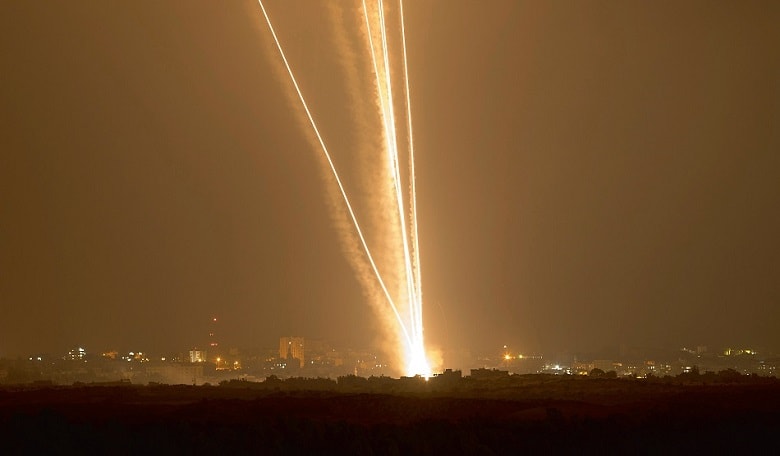Since the October 1973 Yom Kippur War, and increasingly since the 1980s –including as recently as the summer of 2014 – the State of Israel has faced the problem of how to defend itself against a wide range of ballistic missiles of various ranges, rockets and cruise missiles. These have included Katyushas and mortars launched from Lebanon during the 1980s and 1990s, Scud missiles fitted with 250 kg warheads fired from Iraq during the first Gulf War in 1991, and more than 18,000 rockets from Lebanon and Gaza since 2001.
As early as the 1980s, Israel started development of the Arrow system for high-altitude interception of heavier, mid-to-long-range threats. The decision to develop supplementary systems against rockets and missiles, for interception within the atmosphere, and to provide an additional defence layer for interception outside the atmosphere, was taken by the Israel Ministry of Defense (IMoD) in 2005 (even before the Second Lebanon War).
In the same year, the IMoD, together with the US Department of Defense, decided to develop the David’s Sling weapon system for the interception of tactical ballistic missiles, short-range ballistic missiles and cruise missiles. In 2006, the IMoD chose Rafael to be the prime contractor for development of the interceptor and system. Rafael selected US defence contractor Raytheon as its strategic partner to help develop and produce the interceptor as well as additional system components.
The trigger for development of a short-range defence system was the rising number of rockets and mortar shells from the Gaza Strip and the understanding that this threat would only increase alongside the ongoing threat from Lebanon and Syria to the north. This was coupled with the pressure created after the Second Lebanon War in 2006. Two years later, the IMoD selected the Iron Dome system out of numerous proposals and chose Rafael to develop it. The main directive was to develop the performance capabilities for interception of short-range rockets within a very short timescale.
Creating the Iron Dome system meant overcoming a number of major challenges. We would need to develop a new technology for the interception of rockets by means of interceptor missiles while keeping the costs of each interception and the overall system low, all the time adhering to a strict timetable.
When the decision to commission Iron Dome was taken, many people in the defence community, both in Israel and abroad, thought it would be impossible to develop a missile-based system that could neutralise short-range threats. They doubted both the capability of missiles to intercept small targets whose flight time is measured in seconds, and also the economic viability of such a system, in which the interception price was required to be very small relative to existing interception systems.
Rafael chose to develop several potential technologies for the system simultaneously. For each of the assemblies and sub-assemblies, parallel processes and trials were carried out in order to save time. At the end of the process, after conducting lab tests, the most suitable solution was chosen.
During that time, every one of the components was examined from the aspect of its production cost, so that the price influenced the design (design-to-cost methodology). This included use of off-the-shelf components that are not customary in the defence industry. This approach to design stemmed from the understanding that an extremely high number of threats would have to be intercepted. The unit price of each interceptor, therefore, would have to permit the interception of potentially thousands of threats at a price that the country could bear.
Development and production teams worked together on the assemblies from the outset, meaning knowledge was shared from the start. The development teams were chosen according to their professional and functional profiles, as well as their suitability for a challenging project of this type. Older and experienced engineers were integrated with young engineers, in joint teams.
The technological achievement was therefore based on the development concept just described as well as on successfully integrating a wide range of knowledge and existing technologies: from Rafael, partner organisations such as Israel Aerospace Industries and mPrest, the IMoD and the Israel Defense Forces.
During the development of Iron Dome, Rafael accelerated processes that would generally take much longer, and also sped up the development of sub-assemblies and systems that had begun several years earlier in R&D activity, transferring them from the R&D stage to an accelerated project channel. The quality processes were carried out in parallel to development, and problems were handled on the spot. Numerous development trials were conducted, at first on a partial system, in order to find points of weakness and correct them as early as possible.
The culture within the development group and in relations with IMoD and the Israeli Air Force (IAF) was open and without ‘punishment’ for failures resulting from taking calculated risks. This approach meant the developers could examine various solutions with different degrees of risk and, in turn, contributed to a significant reduction in development time.
Production and purchasing were carried out even before development of the system was complete. While this entailed the risk that some purchases would be replaced after development was finished, a significant amount of time was saved, mainly regarding the long-lead-item components. In the end, most of the hardware purchased was found to be suitable and the production times were significantly shortened.
The close working relationship we enjoyed with the IMoD and IAF (Air Defenders) allowed us to develop a system that would meet operational needs and requirements and avoid mistakes, right from the first planning stage through to system implementation with the end user. This process continues to this day in parallel to the operational use of the system, which has already achieved more than 1,700 interceptions.
As a result of this approach to the project we succeeded in developing a system in less than three years that in the beginning was thought to be technologically impossible. It has been an undoubted success, in terms of development, implementation with the customer, and operational effectiveness. According to the IDF, in the most recent confrontation, Iron Dome achieved an interception success rate of more than 90 per cent. This was done while keeping within budget.
The methodology of creating Iron Dome and the technology developed during the project is now being implemented both directly and indirectly in other projects at Rafael, opening new possibilities and technological breakthroughs in a large number of development projects.














